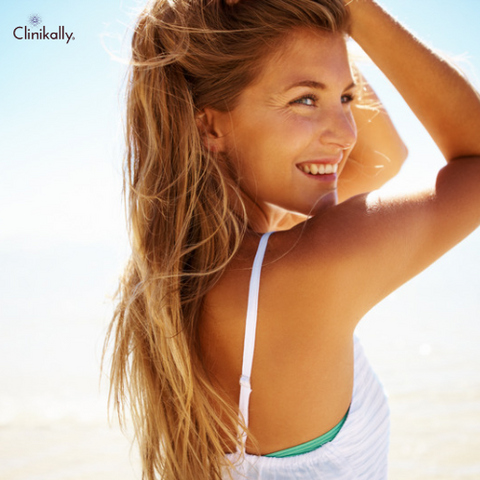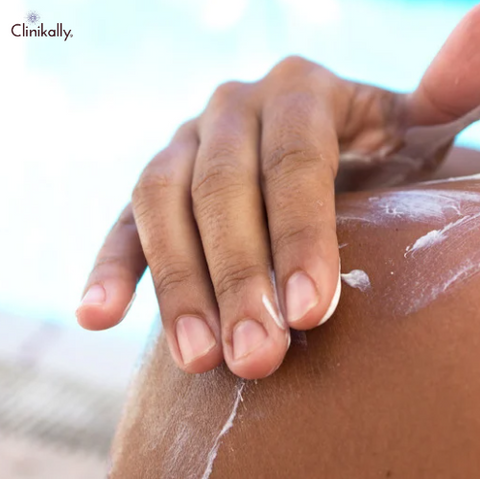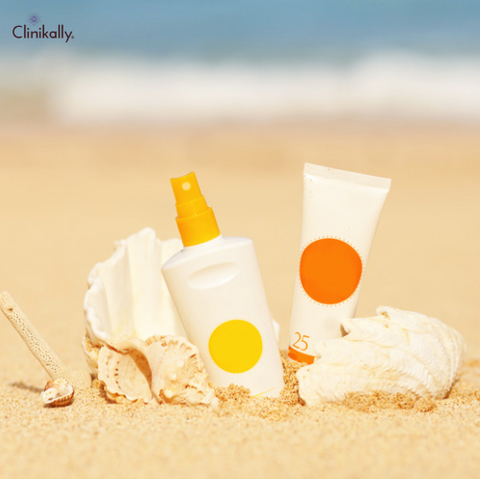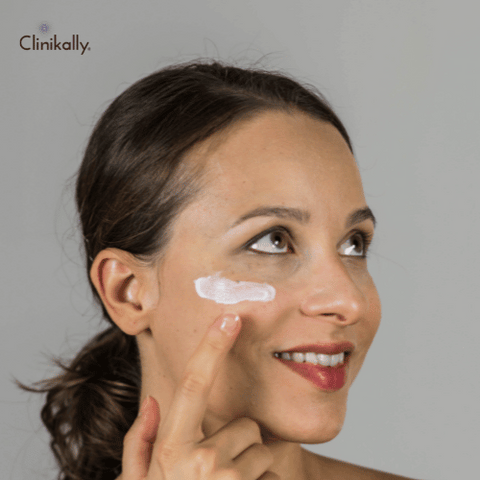A typical UV-absorbing component found in sunscreens is octisalate. It frequently works in conjunction with other active substances, such as avobenzone, to offer broad-spectrum UVA and UVB protection. When used in accordance with instructions, octisalate can be a safe and useful component of sunscreen creams. However, if you have any worries or inquiries about the safety of a certain sunscreen product, it's always a good idea to study the ingredient list and speak with a physician.
What is Octisalate and How Does It Work in Sunscreens?

The chemical octisalate, which is a component of sunscreen, absorbs UVB radiation. It is also known as ethylhexyl salicylate and is a clear, oil-soluble liquid. When octisalate is applied to the skin, a shielding film forms, absorbing UVB rays and transforming them into less damaging energy. It frequently cooperates with other chemicals found in sunscreen to provide broad-spectrum protection from UVA and UVB radiation. The use of octisalate in sunscreens at a maximum concentration of 5% has been approved by the FDA.
Octisalate: An Overview
Octisalate, sometimes referred to as ethylhexyl salicylate, is a chemical sunscreen component that shields skin from UVB radiation's damaging effects. It is a clear, oil-soluble liquid that is frequently combined with other components in sunscreen to offer broad-spectrum defence against UVA and UVB rays. The mechanism of action of octisalate is the formation of a shielding film on the skin's surface that absorbs UVB light and changes it into less damaging energy. According to FDA approval, it is frequently used in sunscreens at a concentration of up to 5%. Although octisalate has been approved for use in sunscreens, some people have expressed concern about its possible effects on the environment and its capacity to enter the skin and interfere with hormone balance. Use octisalate-containing products in accordance with the label's instructions, as you should with all sunscreen ingredients, and think about your unique needs and concerns when choosing a sunscreen.
UVB Protection and Octisalate's Function
The chemical sunscreen ingredient octisalate absorbs UVB radiation. UVB radiation, which is known to increase the risk of skin cancer, is what causes sunburns. When octisalate is applied to the skin, a shielding film forms, absorbing UVB rays and transforming them into less damaging energy. It frequently works in conjunction with additional sunscreen chemicals to offer broad-spectrum defence against UVA and UVB radiation. Octisalate, when combined with other sunscreen active ingredients, can offer reliable defence against the damaging effects of UVB radiation. Remember to reapply sunscreen after swimming, perspiring, or prolonged sun exposure to provide sustained protection. Sunscreen products should always be used as advised.
Evaluating the Safety of Octisalate in Sunscreen Products

At doses up to 5%, octisalate has received regulatory agency approval for usage as a sunscreen component. As long as it is used according to instructions, it is regarded as safe for use in sunscreen products. Octisalate, however, may have the ability to permeate the skin and alter hormonal equilibrium, according to certain research. In particular, octisalate has been shown to have negligible estrogenic effects in animal experiments. It has also been found in human breast milk and urine, suggesting that it may be absorbed through the skin.
However, it is crucial to remember that research on humans has not shown any significant hormonal effects at the dosages normally used in sunscreen lotions. Additionally, the quantity of octisalate that is absorbed through the skin is generally thought to be modest. Like every component in sunscreen, octisalate might have an effect on the environment. It is a synthetic compound that could possibly build up in aquatic settings and be found in wastewater. Additionally, several studies have suggested that octisalate and other chemical sunscreen active ingredients may wreak havoc on marine ecosystems and cause coral bleaching. Some people might prefer mineral-based sunscreens because they don't contain octisalate or other synthetic ingredients. Although octisalate has been approved for use in sunscreens, it is still crucial to take into account each person's needs and concerns when choosing a sunscreen product. Alternative sunscreen solutions, such as mineral-based sunscreens or physical sun protection techniques like hats and clothes, may be of interest to people who are worried about the potential consequences of octisalate on hormone balance or the environment.
FDA Regulations and Octisalate Safety
The US Food and Drug Administration (FDA) recognizes octisalate as a sunscreen component that is both safe and effective. The FDA regulates sunscreen products as OTC medications and establishes guidelines for their effectiveness and safety. The FDA proposed new rules for sunscreen products in 2019. These rules included demands for more safety information on 12 active sunscreen chemicals, including octisalate. According to the proposed regulations, sunscreen producers must carry out research on these compounds' systemic and absorption-related effects in order to assess how safe it is to use them. However, octisalate continues to be an FDA-approved ingredient in sunscreen products and has been used safely for decades until these regulations are finalized and put into effect.
Dermal Absorption and Potential Risks
Because of its limited tendency to irritate skin or cause allergic responses, octisalate is typically regarded as safe for inclusion in sunscreen products. Its potential for dermal absorption and buildup in the body, however, is cause for caution. The term "dermal absorption" describes a substance's capacity to permeate the skin and enter the bloodstream. Octisalate may be absorbed to some extent, however, research has shown that it has low systemic toxicity and does not build up in the body.
Octisalate and other popular sunscreen chemicals were found to be absorbed into the bloodstream at amounts that were much below the FDA-set threshold for toxicity, according to a 2019 study that was published in the Journal of Investigative Dermatology. Octisalate did not build up in the body over time, according to a different study that was published in the journal Photodermatology, Photoimmunology, and Photomedicine in 2018. Although there is a possibility that octisalate will be absorbed through the skin, current research suggests that this is unlikely to have a significant detrimental effect on health. It is still essential to apply sunscreen correctly and limit your exposure to the sun if you want to lower your risk of getting hurt.
Octisalate's Performance in Sunscreen Formulations

For instance, sunscreen formulations intended to offer broad-spectrum protection against both UVA and UVB rays frequently contain the chemical octisalate. It frequently works better when combined with other UV filters like avobenzone and homosalate to increase the effectiveness of sunscreen as a whole. The benefit of octisalate is that it blends well with various cosmetic ingredients, making it simple to incorporate into sunscreen formulations. Additionally, it is stable and slow to degrade in the presence of sunlight, which adds to the consistency of sun protection over time. Since it protects the skin from UVB rays, octisalate functions well as a UV filter. However, it is less effective at blocking UVA light when compared to some other UV filters, like avobenzone and zinc oxide. In order to provide broad-spectrum protection, octisalate is frequently combined with other UVA-blocking compounds. Octisalate is a helpful component of sunscreen formulations that offers efficient UVB radiation defence and is inert to a variety of cosmetic ingredients. However, to ensure maximum sun protection, use sunscreens that provide broad-spectrum protection against UVA and UVB radiation.
Photostability and Compatibility with Other Ingredients
Due to octisalate's exceptional photostability, it can continue to effectively shield the skin from UVB rays even after prolonged exposure to sunlight. It is also compatible with a variety of other sunscreen active ingredients, such as zinc oxide, titanium dioxide, and avobenzone, which can offer a broader spectrum of UVA and UVB protection. Additionally, octisalate is usually regarded as safe for use in sunscreen formulas and has a low risk of causing skin irritation. To improve the effectiveness of other UV filters and offer the best possible sun protection, it is frequently used in conjunction with them.
Enhancing Water Resistance in Sunscreens
When selecting a sunscreen, water resistance is crucial to take into account, especially if you anticipate being in the water or perspiring a lot. Without water resistance, sunscreens are easily washed off, losing their efficacy and leaving the skin susceptible to solar damage. There are a few chemicals that can be added to sunscreen formulations to improve water resistance. One of the most commonly used water-resistant chemicals is dimethicone, a silicone-based substance that forms a protective barrier on the skin's surface and aids in preventing the sunscreen from being washed away by water.
Aside from polyethylene, which resembles plastic and can form a water-resistant barrier, other water-resistant chemicals that may be used in sunscreens include acrylates copolymer, a synthetic polymer that forms a film on the skin. It's crucial to remember that no sunscreen can offer 100% water or sweat protection, so you should still reapply sunscreen frequently, especially after swimming or perspiring. Look for sunscreens with the designation "water-resistant" or "very water-resistant," and always apply and reapply according to the directions on the package.
Alternatives to Octisalate in Sunscreen Products

Although octisalate is thought to be safe for use in sunscreen products, some individuals might favour different chemicals. Zinc oxide, a mineral component that offers broad-spectrum defence against both UVA and UVB rays, is one substitute for octisalate. For those with sensitive skin or allergies to the chemicals in sunscreen, a zinc oxide is a suitable option because it is also usually regarded as safe and effective.
Avobenzone, a chemical component that offers broad-spectrum UVA protection, is an additional option. Avobenzone can offer more dependable and enduring protection than octisalate since it is less prone to degrading in the presence of sunlight. However, it could also irritate some people's skin. You should also think about using titanium dioxide, Mexoryl SX, and Tinosorb S and M as substitute components. It is crucial to keep in mind that some of these compounds might not be readily available in all sunscreen creams or might not be permitted for usage in all nations. As a result, it's crucial to perform your study and pick a sunscreen item that suits your unique requirements and preferences.
Mineral Sunscreen Ingredients: Zinc Oxide and Titanium Dioxide
Two popular mineral sunscreen components that reflect and scatter UV rays are zinc oxide and titanium dioxide. As opposed to chemical sunscreens, these components are frequently chosen by people with sensitive skin because they are less likely to irritate their skin or trigger allergic reactions. Sunscreens with higher SPF values frequently contain zinc oxide, a white, powdery mineral. It offers broad-spectrum defence against UVA and UVB radiation and is extremely photostable, which means it does not degrade quickly when exposed to sunlight. For people with sensitive or acne-prone skin, zinc oxide is a wonderful alternative because it is also believed to have some skin-soothing effects.
Another mineral sunscreen component that offers broad-spectrum defence against UVA and UVB rays is titanium dioxide. Due to the possibility that it might not offer as much protection as zinc oxide at higher concentrations, it is frequently used in sunscreens with lower SPF ratings. The application of titanium dioxide on the skin is typically regarded as harmless because it is highly photostable, like zinc oxide. Regulatory organisations, such as the FDA, normally see zinc oxide and titanium dioxide as safe and reliable sunscreen active ingredients. As opposed to some chemical sunscreen chemicals, they do not present the same threats to marine life, hence, they are also regarded as being environmentally benign.
Weighing the Pros and Cons of Different Sunscreen Ingredients
In order to choose the best sunscreen, it's important to consider both the advantages and disadvantages of different ingredients. Here are some ideas to consider:
-
Sun protection: Look for a sunscreen that protects against UVA and UVB rays. The majority of the time, people believe that mineral sunscreens with zinc oxide or titanium dioxide are effective.
-
Skin type: Consider your skin type as well as any allergies or sensitivities you may have. Chemical sunscreens may irritate some people, whereas mineral sunscreens may cast a white tint on darker skin tones.
-
Impact on the environment: If you're worried about how sunscreen will affect the environment, look for reef-safe options that stay away from dangerous chemicals like oxybenzone and octinoxate.
-
Absorption: Some chemical sunscreens ingredients, like octinoxate and octisalate, can be absorbed into the bloodstream. If you're concerned about potential health risks, consider using mineral sunscreen.
-
Cosmetic compatibility: Pick a lightweight sunscreen formula that won't pill or feel heavy on the skin if you intend to wear makeup over your sunscreen.
The sunscreen that offers the protection you require while also attending to any particular concerns you may have is, in the end, the one you'll use consistently.
Choosing the Right Sunscreen: Factors to Consider

There are a number of things to take into account when choosing sunscreen. The following are important things to bear in mind:
-
Sun Protection Factor (SPF): Look for a sunscreen with at least an SPF of 30, which can block up to 97% of UVB rays.
-
Broad-spectrum protection: Ensure that the sunscreen protects against both UVA and UVB rays.
-
Skin type: When selecting a sunscreen, take into account your skin type. For instance, if your skin is oily, look for a formula that is light and oil-free.
-
Activity level: Look for a sunscreen that is water-resistant if you intend to be active outside.
-
Ingredients: Take into account the sunscreen's ingredients as well as any potential allergies or sensitivities.
-
Application: Choose a sunscreen that goes on smoothly, doesn't leave a white residue, and doesn't make the skin feel greasy.
-
Packaging: Select sunscreen in a container that is easy for you to carry around and use all day long.
-
Personal preferences: Lastly, take into account your own preferences, including brand, texture, and scent. Find a sunscreen you like to use so you will be more likely to use it regularly.
Skin Type and Sunscreen Selection
Your skin type should be taken into consideration when choosing a sunscreen so that you can make an informed decision. Here are some recommendations:
-
Oily skin: In order to prevent clogging pores and causing breakouts, look for sunscreens that are labelled as "oil-free" or "non-comedogenic." Think about a light formulation that won't feel greasy or heavy on your skin, like a gel or liquid.
-
Dry skin: To help hydrate your skin and protect it from the sun, choose a sunscreen with moisturising ingredients. In order to help retain moisture, look for ingredients like hyaluronic acid or glycerin.
-
Skin sensitivity: You should stay away from sunscreens that contain fragrances, preservatives, or other potentially irritating ingredients if you have sensitive skin. To reduce the chance of irritation, look for products that are marked as "hypoallergenic" or "fragrance-free."
-
Dark skin: Those with darker skin tones may be more susceptible to hyperpigmentation and sun damage, so it's crucial to pick a broad-spectrum sunscreen with a high SPF. For a product that may be less likely to leave a white or ashy residue, look for one that is specially designed for people with dark skin.
-
Combination skin: If you have different types of skin on different parts of your face, you may need to use different types of sunscreen. Using a lighter gel or liquid formula on your T-zone, where your skin is oilier, and a moisturising cream or lotion on your cheeks and other dry areas, for example, can help you avoid clogging your pores.
Always use broad-spectrum sunscreen with an SPF of at least 30, and reapply it every two hours or after swimming or sweating.
Balancing Safety, Efficacy, and Personal Preferences
When selecting a sunscreen, take into account both safety and efficacy, as well as personal preferences. Here are some suggestions for balancing these factors:
-
Look for broad-spectrum sunscreen: Broad-spectrum sunscreens shield users from UVA and UVB rays, which can help prevent skin damage and lower their risk of developing skin cancer.
-
Make sure to use sunscreen with an SPF of at least 30: Dermatologists advise using sunscreen with an SPF of 30 or higher to offer sufficient protection from UV rays.
-
Consider the formulation: There are many different formulations of sunscreen, including lotions, creams, gels, sprays, and sticks. Pick a formulation that is most effective for your skin type and way of life.
-
Look at the label: Look for active components that are generally regarded as safe and effective, such as zinc oxide or titanium dioxide. Avoid sunscreens with potential allergens or irritants.
-
Check for water resistance: If you plan to spend time in the water or sweat a lot, look for a sunscreen that is labelled as water-resistant.
-
Consider your own preferences: Some people prefer fragrance-free or natural sunscreens, whereas others prefer sunscreen that dries quickly and does not leave a white cast.
-
See a dermatologist: If you have specific concerns or questions about the safety or efficacy of sunscreen, consult a dermatologist for personalised advice.
















